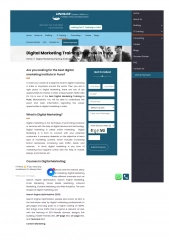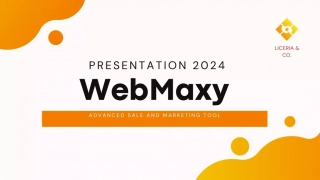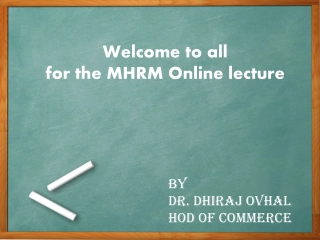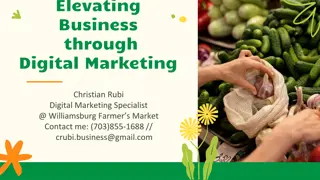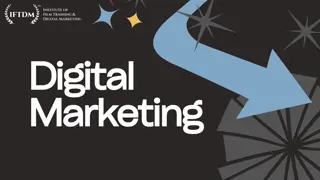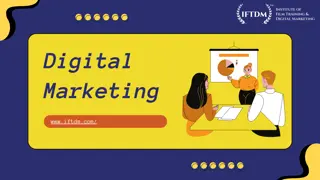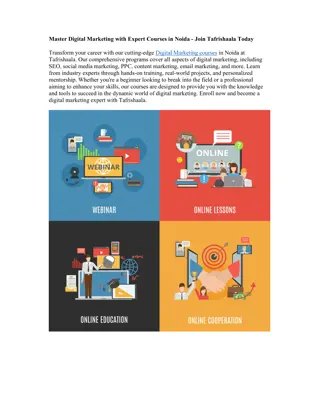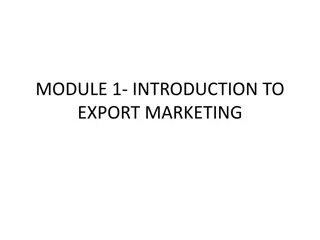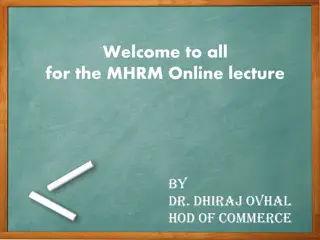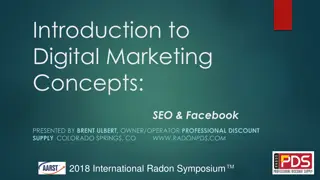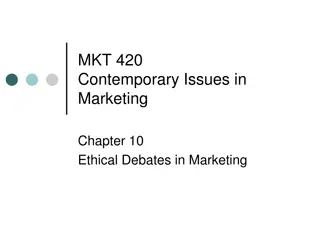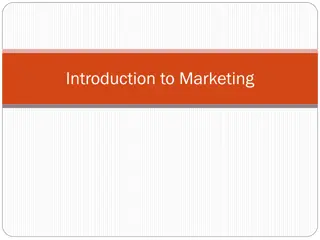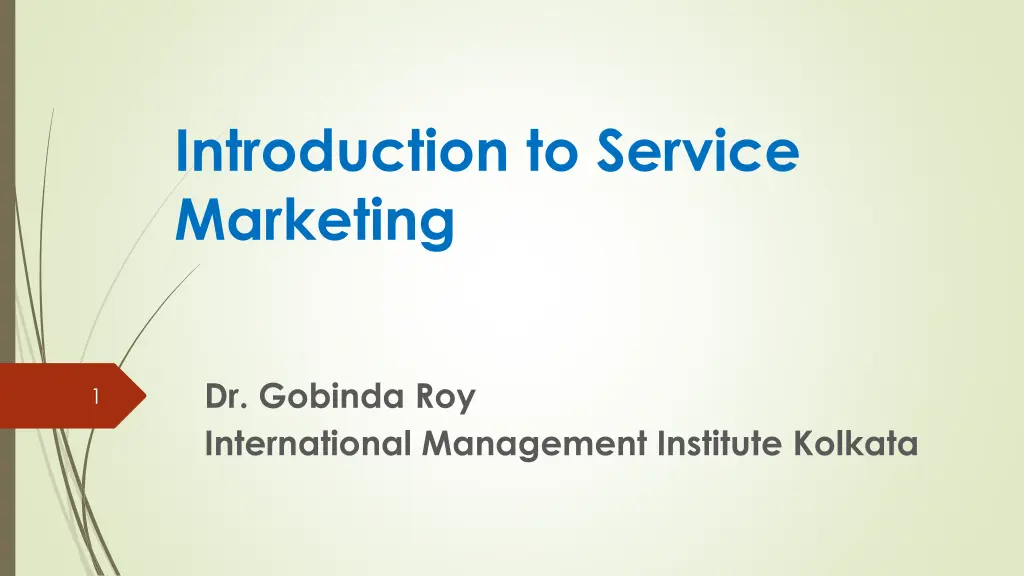
Introduction to Service Marketing in the Decade: Industry Shift and IBM Success
Dive into the world of service marketing with a focus on the shift towards services in the industry, exemplified by IBM's successful transition from manufacturing. Explore the characteristics of services, examples of service industries, and the contributions of service sectors to the economy. Understand the tangibility spectrum and the role of the service sector in India.
Download Presentation

Please find below an Image/Link to download the presentation.
The content on the website is provided AS IS for your information and personal use only. It may not be sold, licensed, or shared on other websites without obtaining consent from the author. If you encounter any issues during the download, it is possible that the publisher has removed the file from their server.
You are allowed to download the files provided on this website for personal or commercial use, subject to the condition that they are used lawfully. All files are the property of their respective owners.
The content on the website is provided AS IS for your information and personal use only. It may not be sold, licensed, or shared on other websites without obtaining consent from the author.
E N D
Presentation Transcript
Introduction to Service Marketing Dr. Gobinda Roy International Management Institute Kolkata 1
Services are going to move in this decade to being the front edge of the industry Manufacturing giant IBM has sifted its from manufacturing PC units to services including product support services, IT consulting, network Consulting services. Changing from manufacturing to services require mind-set changes changes in culture, ways people work. IBM successfully managed it! 2 Research division in IBM has adopted changes to focus on service Science and Service Innovation Many large manufacturing and IT companies follow the IBM ways for Competitive advantage.
3 What are Services? Why Service Marketing? Service and Technology Characteristics of Services Service Marketing Mix Staying Focused on the Customer
What are the services? 4 Services are the deeds, processes, and performances providedor coproduced by one entity or person for another entity or person. Services are not tangible things that can touched, seen, and felt. Rather are intangible deeds and performance provided and/or coproduced for this customers. Examples include IT services, Training, Air lines services, etc.
Examples of Service Industries 5 Health Care hospital, medical practice, dentistry, eye care Professional Services accounting, legal, architectural Financial Services banking, investment advising, insurance Hospitality restaurant, hotel/motel, bed & breakfast ski resort, rafting Travel airline, travel agency, theme park Others hair styling, pest control, plumbing, lawn maintenance, counseling services, health club, interior design
Contributions of Service Industries to U.S. Gross Domestic Product 6
Tangibility Spectrum 8 Some products are purely intangible consulting Some products have both tangible and intangible component- fast-food industry
Why Service Marketing? 9 Services dominate India and worldwide economies Service as a business imperative in goods-focused businesses (Example?) Deregulated industries and professional service needs Service marketing is different Service leads to profits
Examples of Goods Companies that are Expanding into Services 12 Image:Otis.gif
Service as a business Imperative in Good-Focussed businesses* 13 Traditional service industries (banking, transportation, health care) have been evolved and become more competitive. This creates need for service innovation and service growth strategies. Even manufacturing companies (GE, Caterpillar) feels that excellent products are not enough to retain customers. Customer needs superior supports. Xerox took initiative of document management system (digital and papers). Why these companies are focussing onto services?
Service as a business Imperative in Good-Focussed businesses 14 Commoditization of products has resulted in price and margin pressure (e.g. mobile phones). Services can help customers to customize the offering, adding value for the customers. Customer in demanding product and support solutions (mainly in B2B case) (example, IBM servers solutions to corporate). This require both products (servers, routers, IT peripheral devices etc.) Service often provide higher profit margin, and opportunity for upselling. (Power system with AMC).
Is service marketing different?* 15 Gary knisely, a principle of Consulting frim Smith and Knisely, conducted a series of interviews of experts. Consumer goods companies can not directly use marketing practices used in the service firm. Reasons? More variables exist in marketing mix of a service company than a manufacturing company. In a service company, marketing and operation is closely linked than that of manufacturing company (e.g IBM s IT solution and integration business). Customer interface is direct in service firm (hotel manager whereas, manufacturing company hardly face customers (Dettol no direct link customers) In service, your people is the key to business success as people-on people sales. guest),
Why service stinks? 16 Company provided tiered services based on profitability, some segments (low profit margin) get neglected in this way. Increasing adoption of self-service and technology based service (automated voice support service for Airtel pre-paid customers, SBI e- Zone). Customer expectation is high in all industries, because of excellent service they got from few service providers. Hence, they expect same service from all other service providers. Less-skilled people at the front desk and less training provided to front line professionals.
How to compete strategically through service?* 17 Exemplary Out-of-box customer service: Gain competitive advantage using out-of-box services. (Southwest Airlines distinct sense of humour and employees, in-flight games and jokes) At Gallery Furniture, free food and day care for kids Innovative and cutting-edge service: being the first to provide service with inventions, technology, and science. (Amazon first introduced online shopping; Airbnb, Inc. is an American company which operates an online marketplace and hospitality service for people to lease or rent short-term lodging including)
How to compete strategically through service? 18 Value-added, revenue producing services: Besides servers selling, IBM sells integrated services (end-to-end consulting services). PeTSmart, largest pet retailers in US selling pet items, in addition to pet parent offering pet training, grooming, and over night care. A service culture that differentiates: You can serve better, if you hire best workers from Industry, and help him/her to excel and feel for company. Happy employee can make customer happy. Hence target for employer of choice . E.g.- Take care your employee, they will take care your guest (Marriott)
Eight Central Paradoxes of Technological Products 19
Characteristics of Services Compared to Goods* 20 Heterogeneity Intangibility Simultaneous Production and Consumption Perishability
Implications of Intangibility 22 Services cannot be inventoried Services cannot be easily patented Services cannot be readily displayed or communicated Pricing is difficult
Implications of Heterogeneity 23 Service delivery and customer satisfaction depend on employee and customer actions Service quality depends on many uncontrollable factors There is no sure knowledge that the service delivered matches what was planned and promoted
Implications of Simultaneous Production and Consumption 24 Customers participate in and affect the transaction Customers affect each other Employees affect the service outcome Decentralization may be essential Mass production is difficult
Implications of Perishability 25 It is difficult to synchronize supply and demand with services Services cannot be returned or resold
Search, Experience, and Credence Qualities 26
Challenges and Questions for Service Marketers Defining and improving quality Designing and testing new services Communicating and maintaining a consistent image Accommodating fluctuating demand Motivating and sustaining employee commitment Setting prices Organizing to facilitate strategic and tactical decision-making Finding a balance between standardization and personalization Protecting new service concepts from competitors Communicating quality and value to customers Ensuring the delivery of consistent quality service 27
Traditional Marketing Mix 28 Elements an organization controls that can be used to satisfy or communicate with customers: Product Price Place Promotion
Expanded Mix for Services The 7 Ps* Product Price Place Promotion 29 People All human actors who play a part in service delivery and thus influence the buyer s perceptions: namely, the firm s personnel, the customer, and other customers in the service environment. Physical Evidence The environment in which the service is delivered and where the firm and customer interact, and any tangible components that facilitate performance or communication of the service. Process The actual procedures, mechanisms, and flow of activities by which the service is delivered the service delivery and operating systems
Ways to Use the 7 Ps 31 Overall Strategic Assessment Specific Service Implementation How effective is a firm s service marketing mix? Is the mix well- aligned with overall vision and strategy? What are the strengths and weaknesses in terms of the 7 Ps? Who is the customer? What is the service? How effectively does the service marketing mix for a service communicate its benefits and quality? What changes/ improvements are needed?
32 Thank you!



